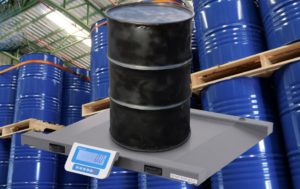Accuracy is obviously a very important goal with all weighing equipment. There are several things that you can do to assist with making sure your weighing devices are providing accurate readings throughout the year.
Use the Correct Type of Scale for your Application
There are many different types of scales that are available. For example when you think of a platform scale, what comes to mind? Probably some type of floor scale perhaps? Did you know that we have floor scales available from as small as 24″x24″ up to 8’x10′ sizes? Capacity choices from 500 pounds up to 40,000 pounds? There are stainless steel platform scales, low profile drum scales that are made for weighing barrels…. etc…
In other words don’t just assume a regular old “floor scale” will be the best choice for your particular application. Email or call the sales department to discuss your application. You might be surprised what scale choices we have to make your job easier. Sure you can use a 2 foot by 2 foot platform scale to weigh large pallets. But a better and safer choice would be a 4 foot by 4 foot platform scale that’s actually designed to weigh regular size pallets.
Use the Scale on a Level Surface
It is important to make sure your scale is sitting on a level surface before you attempt to weigh anything. If the scale is not level, many devices have a level bubble and adjustable feet to assist with this task. Most scales these days offer some type of adjustable feet that allow you to dial in your scale platform so that all four feet are making solid contact.
Check the Scale for Accuracy and Have it Calibrated on a Regular Basis
To ensure accurate readings, you should have your scale(s) checked on a regular basis. We have many businesses throughout central North Carolina that depend on our factory trained scale technicians to keep their weighing equipment working correctly year round. Depending on usage and other factors, most industrial scales need to be calibrated several times a year at a minimum. You can visit Central Carolina Scale.com to setup your calibration visit.
Check and Clean Around and Under your Scale Regularly
If the area around and under your scale platform is not clean, it can absolutely give you inaccurate readings. Dirt, dust, and other debris can build up under and around the scale platform. Carefully clean under and around your platform scales and truck scales periodically for best results. This is probably one of the top three issues we see when customers complain about truck scale weight errors.

Periodically Walk Around & Inspect Your Scales
Seems kind of simple but sometimes a simple walk around your scale(s) is all you need to do. On this stroll you could find a damaged power cord. You could observe that your floor scale is shoved against the wall and not reading correctly. You could observe that your scale operators are not using the scale correctly. We highly recommend that you do this on a consistent basis.
Hopefully these Top 5 tips for accurate scale readings will help you obtain more accurate and consistent weight readings from your scales and weighing equipment. Be sure to browse our website to see all the scales that we offer and the scale repair and calibration services that we provide.